The call to arms
Regular readers of GymCraft will know that in my first article I took a fresh look at the timing for efficient take offs and followed this in the next issue by examining the role of the legs, feet and trunk during take off.
This apparently simple process of jumping from a trampoline is in fact a complex one which of course involves the two topics already discussed but I have so far ignored the part played by the arms in order to focus attention on one area at a time. Let me continue this approach now by making the arm action the main focus.
The best starting point when considering arm action is International rule 16.5 which requires that "the arms should be straight....... ....whenever possible'' This statement is of course intended as guidance relating to ''form'' positions but you may recall my previous assertion that ''good form should be the result of efficient work".
Who would have thought the rule makers would have come up with such a marvellous piece of coaching advice? So there we have it! keep your arms straight whenever possible. I make a clear distinction between ''straight'' and ''stiff'' because many coaches are producing wooden stick like performers who try to impress the judges with a rigid jerky form of movement. I note this particularly in the younger age groups where the natural swinging action of the arms is inhibited by a misguided belief that "form" is a purely visual component.
The aim must be to allow the arms to swing and/or rotate from the shoulder joint with no flexion at the elbow and in a state of optimal tension. Morehouse and Gross in their book ''Maximum Performance'' call it ''dynamic relaxation". This long relaxed swinging action is particularly important throughout the take off and landing phases identified in my first article. at is during these phases that balance and the generation of power are assisted by efficient and well timed arm movements. Many performers fail in this area because they allow a bend to develop at the elbow thereby shortening the lever and limiting the effectiveness of the swing (Fig 1).
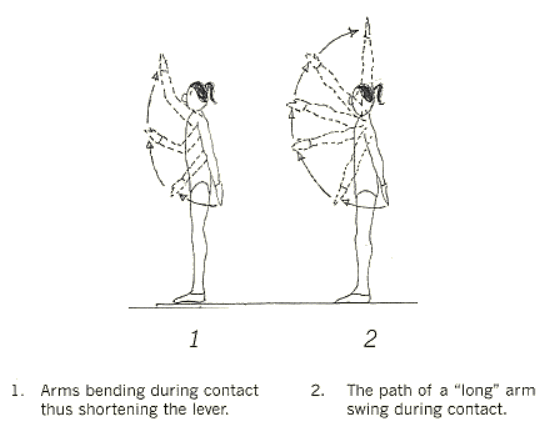
Fig 1
Once the fluid efficient arm action is completed and the performer is airborne attention can be given to maintaining a tight straight arm position to maximise the aesthetic body line shown during the flight and resulting from the efficient work in the bed.
It is this ability to create fluid efficiency without undue tension at the wrong time which characterizes world class performance in all sports. No wonder we admire the ''beauty'' and ''grace'' of the 400 metre runner or the Olympic swimmer who are ultimately judged on their speed rather than aesthetics. My contention is that if we focus on fluid efficiency throughout the take off and landing phases, then aesthetic excellence will follow.
The above comments are of a general nature and relate to all take offs and landings whether during a competition routine or during the basic process of producing introductory straight jumping. There follows a series of exercises designed and dare i say proven, to encourage an understanding of the function of the arms and its relationship to posture and leg action.
The exercises should be worked on regularly during the pre-season phase and can be refreshed as part of the regular sessional warm up throughout the year. I would also use them as part of the early preparation of aspiring competitive beginners So that they develop a deeper understanding of the trampoline medium and their empathy with it.
Exercise l (Fig 2)
In order to develop an appreciation of arm efficiency, ask the gymnast to try jumping with their arms held tightly by the sides of their body. As the Joni Mitchell song says ''You don't know what you got till it's gone!'' This is an excellent exercise for teaching an appreciation of correct posture, balance and optimum tension throughout the take off and landing phases as well as focusing attention on the value of the arms currently out of use. No reactive arm movement is allowed and the performer should be stopped as soon as any arm movement is detected. The exercise exposes any small loss of balance due to postural inaccuracy which will cause the gymnast's arms to break away. Aim for three sets of ten bounces and a percentage score can be given for accuracy with the results recorded in order to map progress and provide motivation.
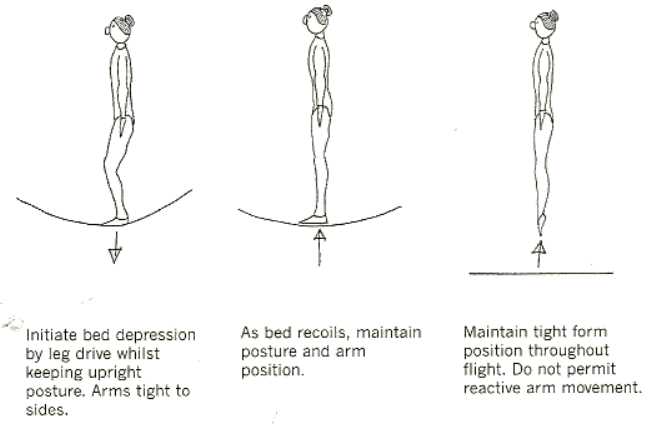
Fig 2
Exercise 2 (Fig 3)
To test the effectiveness of a straight arm swing, stand upright on the trampoline with the knees locked so that no leg push is possible. Start rotating the arms in small but vigorous backward circles. You will find that a correspondingly small but distinct reaction occurs in the bed causing the body to rise and fall. As this reaction continues, gradually increase the size of the arm circling, making sure that the rhythm is sympathetic to the bed’s reaction time. The principle is similar to gradually building up height on a child swing it is essential that the knees are locked so that no assistance is given by the leg action. Ideally, the feet will be kept flat with no toe pointing so that the only height gained comes from the rhythmic work of the arms. The coach needs to check that the performer maintains a "long” arm throughout and should be alert for an elbow bend developing at the bottom of the bounce. As the well timed rhythmic arm circling continues to grow larger, the height above the bed will increase until the arms are reaching directly above the head. Aim for ten jumps after the full arm swing has been attained. Stop the gymnast it any leg action is detected and coaches will find that this is best monitored with gymnasts wearing shorts or a leotard. Once again, the ten bounce format permits the allocation at a percentage score for monitoring purposes.
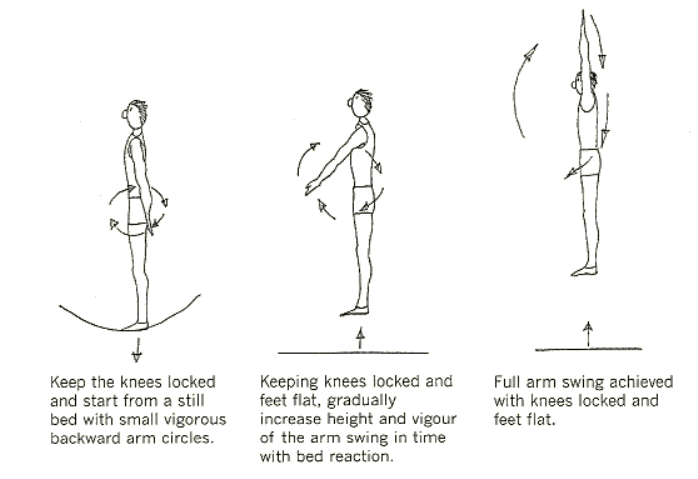
Fig 3
Exercise 3
Begin as in exercise 2 with the knees locked and using only the arms to gain height. Gradually introduce a push with the legs until full jumping height is attained then continue for another ten jumps. Stop the gymnast if the arm action ceases to be long and rhythmical. Again the ten bounce format is for monitoring and specificity. Although I have stressed the "circular" action of the arms, this is an over simplification because as the arms gradually reach higher, the limb track becomes more elliptical. Indeed, it is highly undesirable to maintain a circular path as this will cause the arms to start their downward journey too far behind the line of the body, causing the legs to swing back in flight, creating an arch in the back often followed by a reactive piking prior to landing with risk of instability once contact has been regained. (Fig 4)
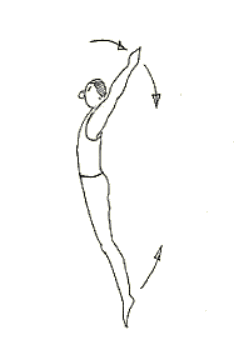
Fig 4
Equally unacceptable is the stopping of the arms at the top of the jump followed by a reactive forward motion causing a dishing during the descent phase. (Fig 5)
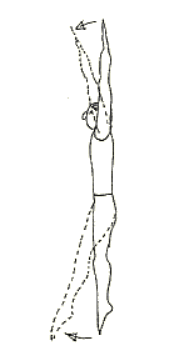
Fig 5
The arms should therefore return from the highest point only slightly behind the line of the body to maintain the integrity of the long arm swing concept, but without creating either of the unwanted reactions described. (Fig 6)
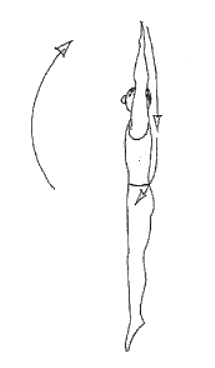
Fig 6
In my next article I will look more closely at the work of the arms during somersault take offs and landings with a particular focus on the contentious matter of "arm setting”.
© Jack Kelly
 ®
®









